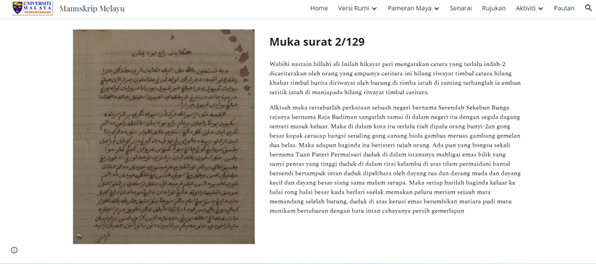From Jawi to Rumi: The Preservation of Malay Manuscripts as a Cultural Heritage
06 June 2022
There are two ways of writing the Malay language. The first is Jawi, a modified form of the Arabic script and the second is Rumi or the Roman script. In olden times, the local Malays probably only wrote and read in Jawi. Therefore, most of the Malay manuscripts that we have today are handwritten in Jawi. With the presence of colonial powers in Malaysia, they brought with them the Latin script and through time, the Malays were taught to write and read in Rumi. However, Jawi was still taught in selected schools.
Today, we see a decline in the number of Malays who can write and read Jawi. The only Jawi newspaper, Utusan Melayu, stopped production on 10 October 2019 due to declining sales. It now appears as a weekly insert in its sister newspaper, Utusan Malaysia. Therefore, the possibility of Jawi becoming a dying script may happen if efforts are not made to encourage its usage. Thus, the University of Malaya Library (UML) took it upon themselves to transliterate their Jawi Malay manuscripts to Rumi. This was done to enable students, researchers and academics who cannot read Jawi to read and use the contents of these manuscripts.
The Manuskrip Melayu project began during Malaysia’s Movement Control Order (MCO) when libraries closed and librarians had to work from home. UML recruited their own librarians who can write and read Jawi but have not been doing it consistently. In more ways than one, the project revived the UML librarians’ interest in the Jawi script, and they were able to transliterate four Malay manuscripts collectively. However, transliteration had its own set of problems such as the difference in spelling of the old and new Malay words, Malay words that are rarely used nowadays and the use of unfamiliar Arabic words in the manuscripts, which the librarians had to resolve
The UML went on to develop the Manuskrip Melayu website, which is different from several other websites that are dedicated to the Malay manuscripts. The website is dedicated solely to Malay manuscripts, and it is currently in the Malay language. In the website, one can locate the following:
- The Rumi version of four Jawi Malay manuscripts
- Hikayat Penerang Hati
- Hikayat Raja Budiman
- Sjair Ikan Teroeboek
- Hikayat Sultan Bustamam
- Virtual exhibitions
- List of UML’s Malay manuscripts
- References to books and research on Malay manuscripts
- Activities for learning the Jawi script
- Links to websites on Malay manuscripts

The original Jawi script of the Malay manuscript is on the left and the transliterated
Rumi script is on the right. This is page 2 of Hikayat Sultan Bustamam.
Thus, this project is not only UML’s effort to revive interest in the Jawi script but also an attempt to preserve the Jawi script. Furthermore, Malay manuscripts are handwritten records of the Malay civilisation. It presents a historical account of the culture and beliefs of the Malays and is therefore a vital cultural heritage that should not only be preserved but also introduced to the world.
Written by: Mahbob Yusof and Juhaida Abd. Rahim, University of Malaya Library, Malaysia